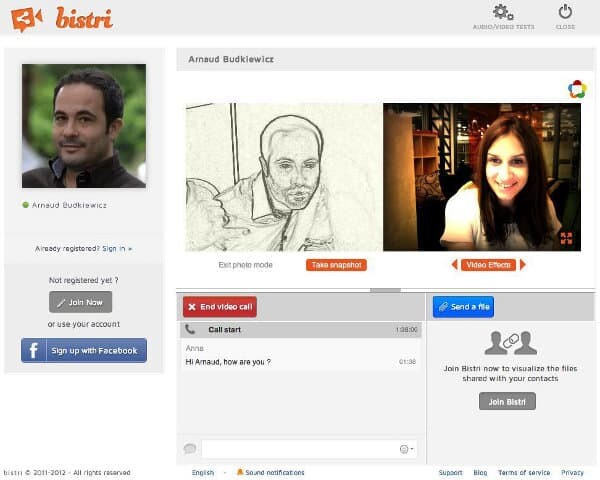Bistri wants to be your communication hub.
My first meeting with Arnaud took place at the WebRTC Conference in Paris a couple of months ago. The idea of Bistri was rather simple at the time: use social networks to sign in, be able to do video calls to communicate and have a sprinkle of video effects on top for fun.
The service has grown since then, with some stickiness features – the ones I like best is the gallery and storage you get when you share files with others – it stays there for future context.

Arnaud Budkiewicz, Co-founder & CEO of Bistri, took the time to answer a few of my questions.
What is Bistri all about?
Bistri simplifies the way we communicate and share things online, with good privacy control.
You get from Bistri a permanent and customizable link, which is like an online phone number, so whenever anyone wants to call you, they just click that link and you’re connected. Share things like you already do in real life in a one-to-one private conversation!
You invested a lot in the files gallery and video effects. Can you explain a bit the reasons behind it?
Online personal communications are mainly made of text and pictures; the professional use is made of documents and large presentations. In both situations one lose a lot of time searching a picture received, a document sent. Bistri provides a better way to manage things, and if the user experience is nice and secure, it’s even better! We have designed the UI of Bistri as neutral as possible to let the users feel at home as they add pictures, videos and other stuff.
When one make a video call, even with a recent webcam offering HD quality, one never look as good as in reality, due to the lack of light, the angle etc.,. Effects are a way to look better, but it is also a very simple way to have fun, without no additional installation.
And just one click is enough on Bistri to share the result it on your favorite social network.
What differentiates you from Rounds and other OTT players that target the same casual users market?
We are focused on a usage by a huge number of human beings who care about the simplicity of the service, interoperability and the quality of relationships. We believe they are mainly one-to-one communications, like what basically the stationary telephone offers. Bistri makes a video call experience simple and easy for everybody. We provide a real service you can use all day long and furthermore an all-in-one solution for both your personal and professional usage. And your friends don’t need to be registered on Bistri to be able to call you.

Client side. What signaling do you use in combination with WebRTC?
Since we use XMPP to communicate with other social networks like Facebook, GTalk and Yahoo Messenger, we chose this protocol as our signaling protocol. Bistri Web is built with pure HTML, CSS, and Javascript. Our XMPP client is strophe.js
On the backend server, how does your architecture look like?
A global service requires a scalable and elastic architecture. We use open source and standard solutions, hosted on Amazon EC2. MongoDB, Redis, Postgresql, Mnesia for data management, ejabberd and libjingle for signaling, and REST services in java. We use BOSH to make XMPP running over HTTP.
Specifically for WebRTC, we use a STUN and a TURN server to enable connections and bypass NATs / Firewalls.
I understand that your origins are in Flash. Why have you decided to switch to WebRTC?
Two years ago, when the first drafts of the WebRTC and RTCWeb were written at the W3C and the IETF, we had the vision of a service that would be as simple as a click on a link, without any piece of software to install, respecting open and standards network protocol and codecs. Focused on the user experience we used Flash to build the first beta of the service, but from the beginning it has been encapsulated in order to be replaced or used as a fallback anytime in the future.
In June 2012, thanks to Google’s WebRTC implementation in Chrome, Bistri provided the first service on the web that allows WebRTC p2p video calls. And we launched it right away on a production platform.
What challenges did you encounter with WebRTC, especially since you already had an architecture based on a different technology?
We started Bistri on the bet that WebRTC would be ready 2 years later, at the end of 2012, and we were right! So our architecture is cloud agnostic, totally independent of Flash from the beginning. One of the challenges was on the UX, to help the user to click on new buttons he has never seen anywhere before, in order to let Bistri have access to the camera and the microphone through Chrome. The other challenge was a technical one : how to switch between protocols since we use 4 different protocols (WebRTC, RTMFP, RTMP, RTMPT); the first two are mainly based on UDP so you never know if your packets arrived or have been blocked on the way.
TURN’s support will help to make WebRTC work in some cases that are covered today by other protocols. That’s one of the great news from the beginning of 2013.
What would you change in WebRTC given the opportunity?
Two years after the first draft from the IETF, the technology is ready-to-use thanks to Google Chrome 23. Bistri has officially become a W3C Member in October 2012 to support open Web standards and contribute to the Web Real-Time Communications Working Group.
From the inside, I can tell you that there is nothing to change! The roadmap is perfectly managed, the standard is the right approach, but the success of WebRTC will depend on browser’s implementation, interoperability between each other and native implementation on mobile devices and embedded systems. Audio and Video encoding/decoding need to be implemented on the chipsets to provide the user with the best quality available and save the battery life of the devices.
What’s next for Bistri?
- Bistri Widgets
- WebRTC JavaScript APIs and Low-level REST APIs
- Video calls on Mobile devices (Android, then hopefully iOS)
- Connected TV, ISP boxes, Google TV, Samsung TV…
–
The interviews are intended to give different viewpoints than my own – you can read more WebRTC interviews.

Very good interview, and we’re glad it was a French company in this emerging market
There’s a lot more than just Bistri in France. From my impression, France is one of the main countries where companies are investing today in WebRTC.
Very good interview, and we’re glad it was a French company in this emerging market
There’s a lot more than just Bistri in France. From my impression, France is one of the main countries where companies are investing today in WebRTC.
🙂 Indeed it is true that the existence of global operator Orange as it promotes a certain way